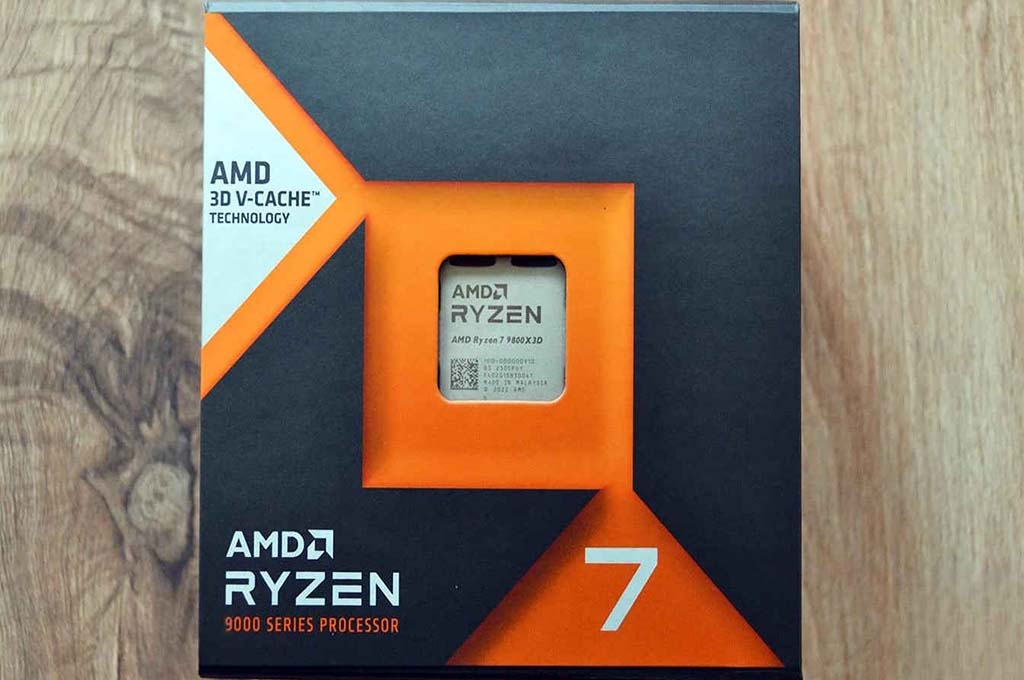AMD Ryzen 7 9800X3D: A Gaming Powerhouse

For PC gaming enthusiasts, the release of the AMD Ryzen 7 9800X3D has brought a breath of fresh air after a somewhat lacklustre year for chip launches. Priced at a reasonable $891.64 (at Amazon), this eight-core, 16-thread CPU, armed with AMD’s enhanced 3D V-Cache technology, has convincingly seized the crown as the fastest gaming processor on the market.
The Secret Weapon: Enhanced 3D V-Cache
AMD has achieved this remarkable performance by refining its 3D V-Cache technology. The new design involves moving the 64MB L3 cache chiplet from the top to the bottom of the processor. This clever change has significantly improved thermal headroom, allowing for higher clock speeds and unlocking the full potential of the Zen 5 architecture in gaming.
While some games may see minimal or even slight performance drops (1-2%) compared to the previous generation, the 9800X3D consistently delivers vastly improved 1% low frame rates. This is especially beneficial when gaming at higher resolutions where the GPU is often the limiting factor.
Overclocking and Productivity Improvements
Unlike previous X3D models, the 9800X3D is fully overclockable, allowing enthusiasts to squeeze out even more performance. This is a welcome addition, and our testing shows that AMD’s Precision Boost Overdrive (PBO) feature is a great option for those who want to push their system further.
The new design has addressed the productivity performance penalties often associated with gaming-optimised X3D processors. The 9800X3D now matches, and sometimes even surpasses, comparable eight-core Ryzen 9000 CPUs in various productivity workloads.
A Breath of Fresh Air in a Disappointing Year
This launch comes at a crucial time. AMD’s own Zen 5-powered Ryzen 9000 series initially delivered underwhelming gaming performance, and Intel’s Arrow Lake Core Ultra series failed to live up to expectations.
The Ryzen 7 9800X3D, however, changes the game. It offers top-tier gaming performance at a reasonable price point, and it slots into existing AM5 motherboards, meaning you won’t necessarily need to invest in the most expensive RAM, coolers, or motherboards.
Technical Deep Dive: What’s New?
The 9800X3D features a 120W TDP, a 5.2 GHz boost clock, and a 900 MHz higher base clock than the 9700X, its direct Zen 5 counterpart. AMD recommends at least a 240-280mm liquid cooler, and while it maintains the same 95°C, the new L3 cache chiplet design allows for higher clock rates over longer periods.
AMD has also upgraded memory support to DDR5-5600. The redesigned 3D V-Cache sees the L3 cache chiplet positioned underneath the compute die, improving thermal transfer and allowing for higher sustained performance. This “Second-Gen 3D V-Cache” (though technically the third iteration) utilises the same 7nm SRAM process and hybrid bonding technology.
While DDR5 latency has increased slightly, the massive L3 cache effectively minimises memory access in many scenarios.
AMD Ryzen 7 9800X3D vs. Intel Core i9-14900K
The battle for gaming supremacy often boils down to a clash between AMD and Intel’s flagship processors. In this corner, we have the newly crowned champion, the AMD Ryzen 7 9800X3D, and in the opposing corner, the formidable Intel Core i9-14900K. While both are high-performance CPUs, they take different approaches to achieving top-tier gaming performance.
Performance Disparity:
Our benchmarks reveal a significant performance gap. On average, the Ryzen 7 9800X3D outperforms the Core i9-14900K by a staggering 30% in our test suite. This substantial lead underscores the effectiveness of AMD’s enhanced 3D V-Cache technology. While the i9-14900K boasts higher clock speeds and a greater core count, the 9800X3D’s massive L3 cache provides a decisive advantage in gaming scenarios.
Architectural Differences:
The Core i9-14900K is built on Intel’s hybrid architecture, combining Performance-cores (P-cores) and Efficient-cores (E-cores) to handle various workloads. While this design excels in multi-threaded applications, the Ryzen 7 9800X3D focuses on optimising gaming performance through its large, vertically stacked L3 cache. This cache reduces latency and improves data access, leading to smoother gameplay and higher frame rates.
Thermal Considerations:
One of the critical improvements in the 9800X3D is its enhanced thermal management. By relocating the cache chiplet to the bottom of the die, AMD has significantly improved heat dissipation. This allows the 9800X3D to maintain higher clock speeds for longer periods, resulting in consistent performance. The i9-14900K, on the other hand, can generate considerable heat under heavy load, requiring robust cooling solutions to maintain optimal performance.
Pricing and Platform:
The Ryzen 7 9800X3D offers a compelling price-to-performance ratio, launching at a more accessible price point than the Core i9-14900K. Additionally, the 9800X3D is compatible with existing AM5 motherboards, providing a more cost-effective upgrade path. The i9-14900K, while powerful, requires a compatible Intel 600 or 700 series motherboard, potentially adding to the overall system cost.
While the Intel Core i9-14900K is undoubtedly a powerful processor, the AMD Ryzen 7 9800X3D emerges as the clear winner in gaming performance. Its innovative 3D V-Cache technology, combined with improved thermal management and a competitive price point, makes it the top choice for gamers seeking the ultimate gaming experience.
Conclusion: The Undisputed Gaming Champion
The AMD Ryzen 7 9800X3D is a triumph. It delivers unparalleled gaming performance, improved productivity, and overclocking capabilities at a competitive price. For UK gamers seeking the best, the 9800X3D is the clear choice. It’s a testament to AMD’s continuous innovation and a much-needed shot in the arm for the PC gaming market.



